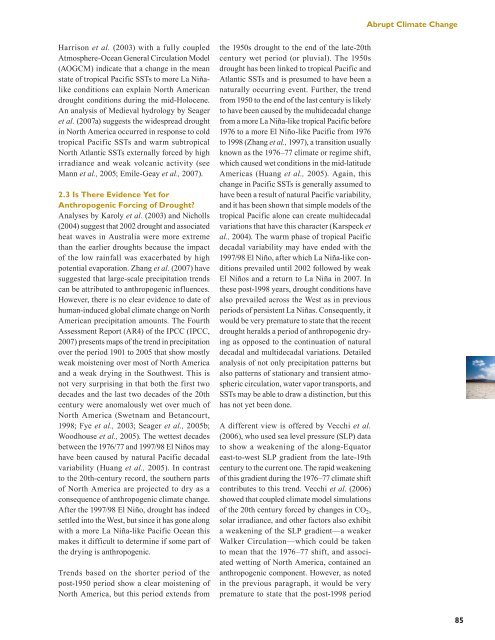Book 2.indb - US Climate Change Science Program
Book 2.indb - US Climate Change Science Program
Book 2.indb - US Climate Change Science Program
- No tags were found...
Create successful ePaper yourself
Turn your PDF publications into a flip-book with our unique Google optimized e-Paper software.
Abrupt <strong>Climate</strong> <strong>Change</strong>Harrison et al. (2003) with a fully coupledAtmosphere-Ocean General Circulation Model(AOGCM) indicate that a change in the meanstate of tropical Pacific SSTs to more La Niñalikeconditions can explain North Americandrought conditions during the mid-Holocene.An analysis of Medieval hydrology by Seageret al. (2007a) suggests the widespread droughtin North America occurred in response to coldtropical Pacific SSTs and warm subtropicalNorth Atlantic SSTs externally forced by highirradiance and weak volcanic activity (seeMann et al., 2005; Emile-Geay et al., 2007).2.3 Is There Evidence Yet forAnthropogenic Forcing of Drought?Analyses by Karoly et al. (2003) and Nicholls(2004) suggest that 2002 drought and associatedheat waves in Australia were more extremethan the earlier droughts because the impactof the low rainfall was exacerbated by highpotential evaporation. Zhang et al. (2007) havesuggested that large-scale precipitation trendscan be attributed to anthropogenic influences.However, there is no clear evidence to date ofhuman-induced global climate change on NorthAmerican precipitation amounts. The FourthAssessment Report (AR4) of the IPCC (IPCC,2007) presents maps of the trend in precipitationover the period 1901 to 2005 that show mostlyweak moistening over most of North Americaand a weak drying in the Southwest. This isnot very surprising in that both the first twodecades and the last two decades of the 20thcentury were anomalously wet over much ofNorth America (Swetnam and Betancourt,1998; Fye et al., 2003; Seager et al., 2005b;Woodhouse et al., 2005). The wettest decadesbetween the 1976/77 and 1997/98 El Niños mayhave been caused by natural Pacific decadalvariability (Huang et al., 2005). In contrastto the 20th-century record, the southern partsof North America are projected to dry as aconsequence of anthropogenic climate change.After the 1997/98 El Niño, drought has indeedsettled into the West, but since it has gone alongwith a more La Niña-like Pacific Ocean thismakes it difficult to determine if some part ofthe drying is anthropogenic.Trends based on the shorter period of thepost-1950 period show a clear moistening ofNorth America, but this period extends fromthe 1950s drought to the end of the late-20thcentury wet period (or pluvial). The 1950sdrought has been linked to tropical Pacific andAtlantic SSTs and is presumed to have been anaturally occurring event. Further, the trendfrom 1950 to the end of the last century is likelyto have been caused by the multidecadal changefrom a more La Niña-like tropical Pacific before1976 to a more El Niño-like Pacific from 1976to 1998 (Zhang et al., 1997), a transition usuallyknown as the 1976–77 climate or regime shift,which caused wet conditions in the mid-latitudeAmericas (Huang et al., 2005). Again, thischange in Pacific SSTs is generally assumed tohave been a result of natural Pacific variability,and it has been shown that simple models of thetropical Pacific alone can create multidecadalvariations that have this character (Karspeck etal., 2004). The warm phase of tropical Pacificdecadal variability may have ended with the1997/98 El Niño, after which La Niña-like conditionsprevailed until 2002 followed by weakEl Niños and a return to La Niña in 2007. Inthese post-1998 years, drought conditions havealso prevailed across the West as in previousperiods of persistent La Niñas. Consequently, itwould be very premature to state that the recentdrought heralds a period of anthropogenic dryingas opposed to the continuation of naturaldecadal and multidecadal variations. Detailedanalysis of not only precipitation patterns butalso patterns of stationary and transient atmosphericcirculation, water vapor transports, andSSTs may be able to draw a distinction, but thishas not yet been done.A different view is offered by Vecchi et al.(2006), who used sea level pressure (SLP) datato show a weakening of the along-Equatoreast-to-west SLP gradient from the late-19thcentury to the current one. The rapid weakeningof this gradient during the 1976–77 climate shiftcontributes to this trend. Vecchi et al. (2006)showed that coupled climate model simulationsof the 20th century forced by changes in CO 2 ,solar irradiance, and other factors also exhibita weakening of the SLP gradient—a weakerWalker Circulation—which could be takento mean that the 1976–77 shift, and associatedwetting of North America, contained ananthropogenic component. However, as notedin the previous paragraph, it would be verypremature to state that the post-1998 period85






